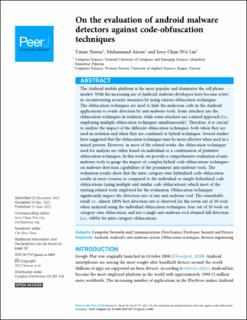| dc.description.abstract | The Android mobile platform is the most popular and dominates the cell phone market. With the increasing use of Android, malware developers have become active in circumventing security measures by using various obfuscation techniques. The obfuscation techniques are used to hide the malicious code in the Android applications to evade detection by anti-malware tools. Some attackers use the obfuscation techniques in isolation, while some attackers use a mixed approach (i.e., employing multiple obfuscation techniques simultaneously). Therefore, it is crucial to analyze the impact of the different obfuscation techniques, both when they are used in isolation and when they are combined as hybrid techniques. Several studies have suggested that the obfuscation techniques may be more effective when used in a mixed pattern. However, in most of the related works, the obfuscation techniques used for analysis are either based on individual or a combination of primitive obfuscation techniques. In this work, we provide a comprehensive evaluation of anti-malware tools to gauge the impact of complex hybrid code-obfuscations techniques on malware detection capabilities of the prominent anti-malware tools. The evaluation results show that the inter-category-wise hybridized code obfuscation results in more evasion as compared to the individual or simple hybridized code obfuscations (using multiple and similar code obfuscations) which most of the existing related work employed for the evaluation. Obfuscation techniques significantly impact the detection rate of any anti-malware tool. The remarkable result i.e., almost 100% best detection rate is observed for the seven out of 10 tools when analyzed using the individual obfuscation techniques, four out of 10 tools on category-wise obfuscation, and not a single anti-malware tool attained full detection (i.e., 100%) for inter-category obfuscations. | en_US |

